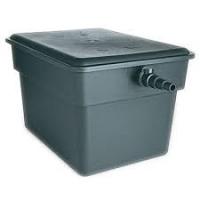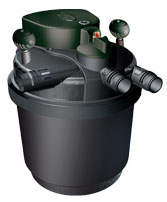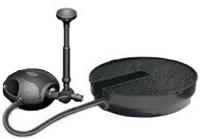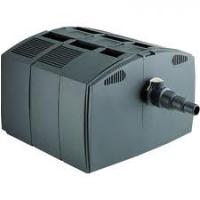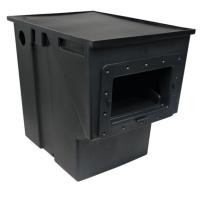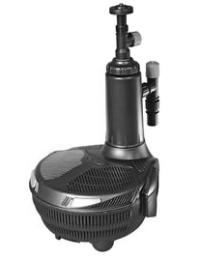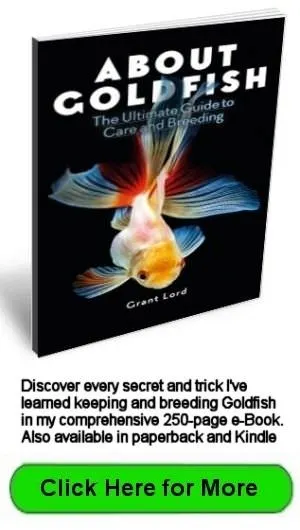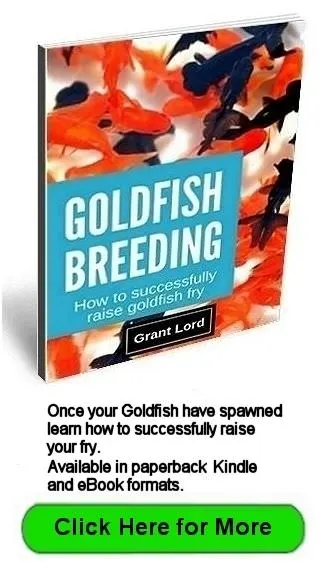- Home
- Pond Filters
Goldfish Pond Filters
Goldfish Pond filters come in a multitude of sizes, designs and filtering capacities.
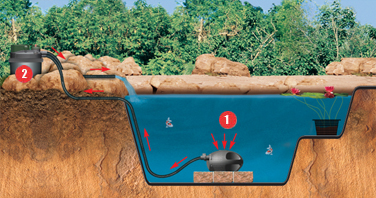
There are many types of Goldfish pond filters available, most at very reasonable prices.
Whatever type of filter you choose, there are basic requirements you will need from your filter based on pond size and fish numbers.
The pond water volume should circulate through the filter once every two hours.
If you purchase a filter that is too small for the pond it will need frequent cleaning. You shouldn’t need to clean the filter more than 4 times a year.
Factors Affecting Pond Filter Efficiency
Pond filters have a rating stating the maximum size pond the filter will handle under ideal conditions. Unfortunately ideal conditions rarely occur for long in a goldfish pond.
Listed below are examples of a pond setup that makes quite different demands on the filter depending on pond placement and fish numbers. Example 1 makes the least demands, and example 4 the most:
Example 1. Low fish numbers, pond in shade
Example 2. Low fish numbers, pond in full sunlight
Example 3. High fish numbers, pond in shade
Example 4. High fish numbers, pond in full sunlight
Goldfish Pond Filter Styles
Before working out the filter size you require, comparing the different filter types and their advantages and disadvantages will help in the final selection process.
Shown below are the more common filter designs available. The advantages and disadvantages shown against each Goldfish pond filter are guides to the features you should be looking for.
Laguna PowerFlo External Box Filter
Advantages:
- Easy access for maintenance
- Pumice filter media supplied (for top tray)
- Filter pad supplied
- UV sterilizer available for larger sizes
Disadvantages:
- Gravity water return so must be installed above the pond
- Large size relative to pond water volume
- Water pump extra
- No backwash feature
- Filter media not supplied (for bottom tray)
- Has to be hidden from view
Laguna Pressure-Flo External Canister Filter
Advantages:
- Easy access for maintenance
- Backwash feature
- Pressurized so can be buried below pond water level
- Foam filter pads included
- Size smaller than other filters in relation to pond water volume
- Cleaning required indicator
- UV sterilizer
Disadvantages:
- Has to be hidden from view
- Water pump extra
- Smallest size doesn't have a biological filter
Laguna PowerFlo Internal Round Filter
Advantages:
- Hidden from view
- Filter pads and media supplied
- Ideal for shallow ponds
Disadvantages:
- Water pump extra
- Quickly clogged by leaves
- Must be removed from pond for maintenance
- No UV sterilizer
Laguna PowerFlo Internal Filter
Advantages:
- Hidden from view
- additional sections can be added
- Filter pads and media supplied
Disadvantages:
- Quickly clogged by leaves
- Must be removed from pond for maintenance
- Water pump extra
- No UV sterilizer
Laguna External Skimmer
Advantages:
- Easy access for maintenance
Disadvantages:
- Must be installed at pond water level
- Water pump extra
- Filter media extra
- No UV sterilizer
Hozelock EasyClear Internal 3 in 1 Filter
Advantages:
- Hidden from view
- Comes with pump
- UV sterilizer
- No plumbing required
- One power lead
Disadvantages:
- Must be removed from pond for maintenance
Filter Selection Steps
After deciding on the style of filter that will suit your installation best, the final three step process starts with calculating the water volume of your pond.
Step One: Calculate Pond Volume
The first and most important task is to calculate the volume of water in your pond. This figure will determine the flow capacity required from your filter.
Square or Oblong Pond Calculation:
Length x width x depth (maximum normal water depth, not the pond wall height).
Example:
6 feet x 4 feet x 3 feet (water depth) equals 72 cubic feet of water.
Multiply this figure by 7.48 to calculate US gallons. (Use 6.23 For Imperial gallons).
If the filter output is quoted in liters, divide the figure by 3.79 for US gallons and 4.55 for Imperial, or just measure in metric. (1 cubic meter equals 1000 liters).
If the pond bottom slopes, take a mid point to measure the water depth.
If you have a deep spot, take the same measurements (L x W x D) and add the figure to the rest of the pond volume calculation.
Round Pond Calculation:
If your pond is round, the calculation is (3.14) x Radius2 x depth.
Example:
For an 8 foot diameter by 3 foot deep pond multiply 3.14 x 42 x 3
Equals 3.14 x 16 x 3
Equals 150 cubic feet. Multiply 150 by 7.48 (6.23 for Imp gallons)
Equals 1127 US gallons (934 Imp gallons)
Tip:
If you have an odd shaped pond that doesn’t lend itself well to normal volume calculations, measure the output from the hose you will fill the pond with into a bucket of known volume (the bigger the bucket the more accurate the measurement).
If it takes say 30 seconds to fill a 2 gallon bucket, and it takes 2 hours to fill the pond, the pond volume is 480 gallons.
(120 min x 60 sec)/30 sec x 2 gals = 480 gallons
If in doubt overestimate volume rather than underestimate
Step Two: Decide On Filter Size (Water Flow Rate) Required
After you have calculated your pond’s water volume, you will know the approximate size of filter you need.
(Remember; the pond water volume should flow through the filter every two hours).
I say approximate because filter outputs are usually calculated based on new installations with clean water passing through the filter. There is no allowance made for clogging of the filter media over time. A small amount of filter clogging can quickly reduce outflow by up to 50%.
Another consideration is seasonal demand on the filter.
The greatest demands are put on your filter in summer. The fish are eating heavily, sunlight hours are high, and water temperatures are elevated so oxygen levels are low.
At this time of year, you could need twice the filtering capacity needed for spring or autumn.
Bottom line...I double the filter size I need. For a 100 gallon pond, I buy a filter that is designed to filter a 200 gallon pond.
Step Three: Compare Features
What you are looking for here are features that save you work. Manufacturers list the features that their product has. By comparing these features, you soon narrow down which product best suits your requirements.
Features could include:
- Backwash facility – this saves you having to disassemble the filter when it needs cleaning (or reduces the frequency).
- Cleaning indicator – shows when the filter is clogged and needs to be backwashed or cleaned out
- Does the filter have a UV sterilizer lamp – this feature kills off suspended green algae and bacteria that filters can’t filter out? (Note it doesn’t kill fibrous algae such as blanket weed)
- Does the filter come with filter media – an extra cost if it doesn’t?
- Does the filter come with a water pump – an extra cost if it doesn’t?
- How easy is it to get spare parts?
- How long is the power lead?
- How long is the product guaranteed for?
- Can you get an idea of how easy the filter is to maintain?
Quality is another important consideration. Generally, you get what you pay for.
As an example, cheaper water pumps have stainless steel impellor shafts. These start to show wear after 6 months. Higher quality filters such as Laguna and Fluval have ceramic shafts that don’t wear out. After three or four years of continuous use, the impellors start rattling indicating they need replacing.
Buying Your Goldfish Pond Filter
You should have a good idea now of the size and style of filter you want for your pond.
If you haven't got a local supplier of the equipment you want, then I suggest Amazon.com is a good safe alternative. Amazon also has the advantage of having many sellers competing for your business.
Read the customer reviews and hear some of the horror stories that occur if you don't know what you actually need. Also, take note of any weaknesses that customers have discovered.
Search under pond filters where you will get thousands of listings. Knowing pretty much what you want before you start searching will save you hours, and ensures you get the best deal.
If you decide to buy second hand, I suggest sticking to the quality brands as you will be able to get spares.
And don't forget that most pond filters do not come with a water pump. The water pump needs to match the pond size, and the biological pressure your filter will be under.
For examples of what affects your water pump selection go to the Goldfish Pond water pumps page.
To learn about UV sterilizers (clarifiers) and their advantages go to the Goldfish Pond UV clarifiers page.
One last thing, make sure the water pump voltage suits your region.
Other Considerations When Installing Goldfish Pond Filters
Always use an RCD (residual current detector), also called a GFCI ground fault circuit interrupter safety device when electricity is used around water.
The filter shouldn’t cause excessive water turbulence. Goldfish prefer still or slow moving water.
During winter filter demands are very low. You want little water movement because the fish will use precious energy swimming against the current. If the filter is in any danger of freezing, turn it off and empty it of water.
Try to install a filter into a clean pond. If the pond water has turned green or there is a lot of suspended material in the water, the filter will quickly clog.
Pond filters must run continuously otherwise the useful bacteria won’t establish in the filter. A filter does little filtering. Its job is to circulate the water and provide a home for useful bacteria that convert waste into harmless compounds.
Top of Goldfish Pond Filters page
